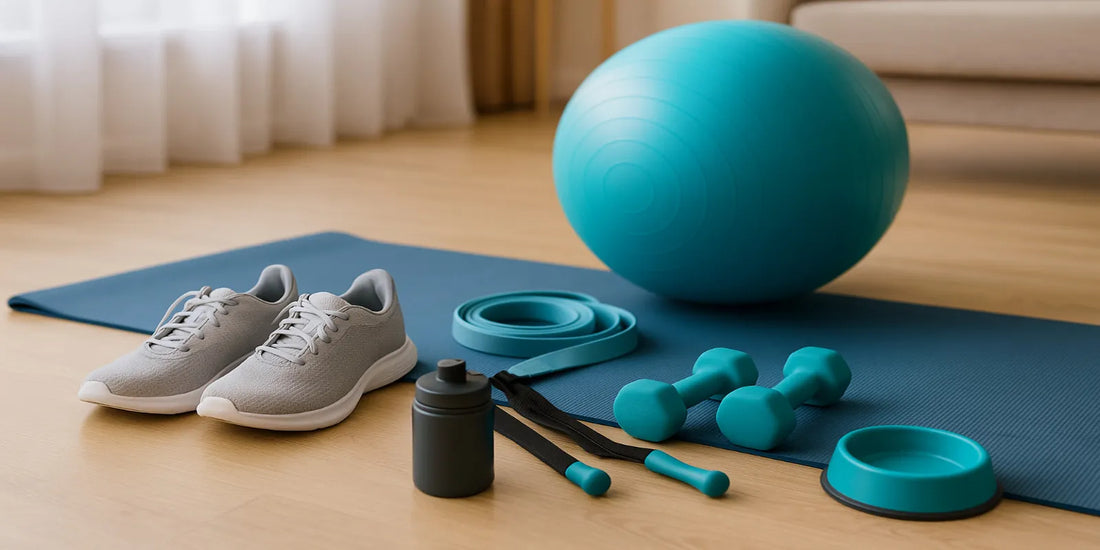
Senior Fitness Gear 2025 – Safe, Low-Impact Essentials for 50+
Share
Senior Fitness Gear – Safe, Low-Impact Essentials for 50+
Turning movement into a daily habit is easier with the right senior fitness gear. Good tools protect joints, add confidence, and make short sessions feel doable. This guide is product-neutral. You will learn how to choose gear, how to set safe targets, and how to build small wins that last.

Why senior fitness gear matters for comfort and safety
Supportive gear keeps intensity in the “just right” zone. Cushioned mats reduce pressure on wrists and knees. Grippy shoes cut slip risk during walks and step-ups. Light bands deliver strength work without heavy joint compression. A balance pad adds safe challenge while you hold a wall or chair.
Global guidelines suggest about 150 minutes of moderate activity each week, plus two strength days and regular balance practice. You can reach those targets with a simple home kit. Start with ten-minute blocks. Add minutes only when form stays steady and breathing feels conversational. See the CDC overview and the WHO guidelines.
The phrase senior fitness gear also means planning your space. Clear floor hazards. Place a sturdy chair near the mat. Keep bands and small weights within easy reach. Hydrate before you begin. Warm up with gentle marching and shoulder rolls. These habits prevent stumbles and strains.
How to choose senior fitness gear that feels good now
Keep choices simple. Pick tools that are light, grippy, and easy to store. Good feel wins over features. If a tool invites daily use, it is the right one.
Joint-friendly checklist
- Walking shoes: wide toe box, firm heel, slip-resistant tread.
- Trekking poles: adjustable height, wrist straps, rubber tips for pavement.
- Resistance bands: one long band and two loop bands; start light.
- Light dumbbells: 1–3 kg; add weight only when form is steady.
- Exercise mat: 6–8 mm thickness for knee and wrist comfort.
- Balance pad: soft foam or wobble cushion; use near a wall.
- Sturdy chair: arms preferred; seat height at knee level.
- Mini step: low platform; height below mid-shin for control.
- Recovery tools: foam roller or massage ball for tight spots.
- Timer or step counter: track 10–15 minute blocks, not calories.
Evidence to guide your picks
Strength training supports function at any age. Light resistance builds muscle without joint stress. See the ACSM position materials (ACSM). Balance practice reduces falls; Tai Chi is effective across studies (Cochrane Review).
Fit and setup tips
- Set pole height so elbows bend about 90°. Keep shoulders relaxed.
- Loop bands around a door anchor at chest height for rows and press.
- Place the balance pad beside a wall or chair you can hold anytime.
- Clear the floor. Remove loose rugs, cords, and clutter before sessions.

Build safe routines with short blocks and calm progress
Use the talk test. If you can speak full sentences, the effort is moderate. If words break apart, ease down. Most sessions can fit in ten to twenty minutes.
10-Minute Starter (do most days)
- Warm-up 2 min: easy march, shoulder rolls, ankle circles.
- Band strength 6 min: 12–15 reps each — chair sit-to-stand, band row, chest press, heel raises with chair, side steps with light loop.
- Balance 1 min: heel-to-toe walk along a line; touch wall as needed.
- Cool-down 1 min: slow breaths in for 4, out for 6; gentle calf stretch.
20-Minute Walker Day
- Walk 6–8 min at a steady pace. Use poles for posture and rhythm.
- Band row and press, 12 reps × 2 rounds.
- Step-ups on a low platform, 8–10 reps each leg, slow and controlled.
- Finish with hip flexor and calf stretches, 20–30 seconds per side.
Micro-drills for busy days
- One set of sit-to-stands whenever you make tea or coffee.
- Single-leg stance while brushing teeth, finger on the counter.
- Two minutes of marching during TV ads or phone holds.
For warm-up, cool-down, and hydration guidance, see the NIA booklet (Exercise and Physical Activity for Older Adults), and the U.S. Physical Activity Guidelines on multicomponent training (PAG).
Stay consistent with senior fitness gear: safety, progress, and FAQs
Safety checklist
- Warm up and cool down every time. Sip water often.
- Use a wall or chair for balance drills. Remove trip hazards.
- Stop if you feel chest pain, dizziness, or unusual breathlessness.
- Start light. Increase band level or weight only when the last reps feel easy.
- Log sessions. Consistency beats intensity after 50.
Progression plan (4 weeks)
- Week 1: 10-minute starter, four days. Short walks on two days.
- Week 2: Add a second strength round on two sessions.
- Week 3: Extend one walk to 20 minutes. Add balance time.
- Week 4: Try a new band color or add 0.5–1 kg to one lift.
FAQ
How often should I train? Aim for most days. Mix walking, strength, and balance across the week.
What if knees hurt? Use poles, reduce step height, and favor band work. Keep ranges pain-free.
Do I need cardio machines? No. Brisk walking, steps, and bands cover the core needs for health and function.
The steady path is simple: pick a small kit, protect joints, and repeat short blocks. With the right senior fitness gear, you build confidence and strength without flare-ups.
